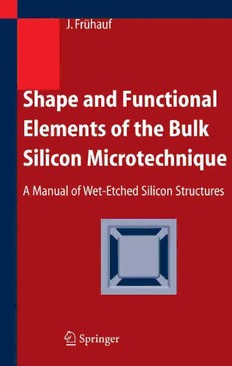Table Of ContentJ. Fru¨hauf
Shape and Functional Elements of the Bulk Silicon Microtechnique
Joachim Fru¨hauf
Shape and Functional Elements
of the Bulk Silicon
Microtechnique
A Manual of Wet-Etched
Silicon Structures
With 165 Figures and 75 Tables
Author
Prof. JoachimFru¨hauf
TechnischeUniversita¨tChemnitz
Fakulta¨tfu¨rElektrotechnikundInformationstechnik
FachgruppeWerkstoffederElektrotechnik/Elektronik
ReichenhainerStr. 70
09107Chemnitz
Germany
ISBN3-540-22109-3 SpringerBerlinHeidelbergNewYork
LibraryofCongressControlNumber: 2004112723
Thisworkissubjecttocopyright. Allrightsarereserved, whetherthewholeorpartofthe
materialisconcerned, specificallytherightsoftranslation, reprinting, reuseofillustrations,
recitation, broadcasting, reproduction on microfilm or in other ways, and storage in data
banks. Duplicationofthispublicationorpartsthereofispermittedonlyundertheprovisions
oftheGermanCopyrightLawofSeptember9,1965,initscurrentversion,andpermissionfor
usemustalwaysbeobtainedfromSpringer-Verlag. Violationsareliabletoprosecutionunder
GermanCopyrightLaw.
SpringerisapartofSpringerScience+BusinessMedia
springeronline.com
(cid:1)c Springer-VerlagBerlinHeidelberg2005
PrintedinGermany
Theuseofgeneraldescriptivenames,registerednames,trademarks,etc. inthispublication
doesnotimply,evenintheabsenceofaspecificstatement,thatsuchnamesareexemptfrom
therelevantprotectivelawsandregulationsandthereforefreeforgeneraluse.
Typesetting: Dataconversionbytheauthors.
FinalprocessingbyPTP-BerlinProtago-TEX-ProductionGmbH,Germany
Cover-Design: design&productionGmbH,Heidelberg
Printedonacid-freepaper 62/3020Yu-543210
Preface
The idea for this manual was created by the author and Birgit Hannemann (now
Professor atthe UniversityofApplied Sciences, Bremen, Germany) asaninternal
catalogue of results of several years of investigations at the Chemnitz University
of Technology, Germany. At this base supplying investigations and the elabora-
tion of the manuscript were supported by the Stiftung Industrieforschung, Bonn,
Germany. In the course of this the coworkers of the author Eva Gärtner, Steffi
KrönertandCorneliaKowolweredirectlyinvolved.
All the SEM pictures result from preparations performed at the Centre of Mi-
crotechnologies at the Chemnitz University of Technology (Head: Prof. Thomas
Gessner).
The author and his coworkers wish to express their thanksto WolfgangBräuer
(mask design), Norbert Zichner (processes), Iris Höbelt (SEM pictures) and the
student Karin Preißler (manuscript layout support). Inparticular thanksare due to
the Stiftung Industrieforschung for the financial support and to the Springer Ver-
lagfortheeditionofthismanual.
Chemnitz, June 2004 Joachim Frühauf
Table of Contents
Symbols................................................................................................................XI
1Introduction.........................................................................................................1
2TechnologicalBasisofBulk-Silicon-Microtechnique......................................5
2.1Thesiliconwaferasabasismaterialofmicrotechnique..............................5
2.2Technologicalprocesses...............................................................................6
2.2.1Thebasicconceptionofthebulk-silicon-microtechnique....................6
2.2.2Depositionandstructuringofpassivationlayers..................................7
2.2.3Wetanddryetchingofsilicon..............................................................8
2.2.4Metallization.......................................................................................10
2.2.5Waferbonding....................................................................................11
2.2.6Plasticreshapingofsiliconmicrostructures.......................................13
3OrientationDependentEtchingofSilicon......................................................17
3.1Fundamentalprinciplesofthegenerationofshapes..................................17
3.1.1Atomicscalefeaturesofsiliconetching.............................................17
3.1.2Theformationofshapesbyetchingmaskedwafers...........................20
3.1.3TheimportanceofdifferentorientedSi-wafersinthemicrotechnique:
{100},{110},{112}and{111}..................................................................30
3.1.4Detectionofthecorrectorientationbetweenwaferandmask............33
3.2Chemistryandtechniquesofwetsiliconetching.......................................37
3.2.1Chemicalreactionsanddependenceontemperature..........................37
3.2.2Influenceofcomposition....................................................................39
3.2.3Influenceofdoping.............................................................................41
3.2.4Equipmentandetchingtechnology.....................................................43
3.2.5Isotropicetching.................................................................................44
3.3Etchmaskdesignandsimulationofsiliconetching...................................46
3.3.1Calculationoftheetchmask...............................................................46
3.3.2Additionofcompensationmasks.......................................................49
3.3.3Simulationanddesigntools................................................................50
3.4Basicprocessesofthebulk-silicon-microtechnique..................................52
3.4.1Shapedefinitionbyvariationofetchsteps.........................................52
3.4.2Changingofthemaskbetweentwoetchsteps...................................55
3.4.3Examplesofthemostimportantbasicprocessesandprocess
interfaces......................................................................................................57
VIII Table of Contents
4GeneralOverviewoftheShape-andFunctionalElementsandthe
ProcedureoftheirDesign....................................................................................71
4.1Surveyandmethodicalprocedure..............................................................71
4.2Guideforthedesignprocedure..................................................................73
4.3Legendofthesketches...............................................................................73
5SimpleShapeElements....................................................................................75
5.1Definitionsofshapesbythecombinationofsidewalls..............................75
5.1.1Typesofsidewallsarisingfromone-stepetchprocesses....................75
5.1.2Typesofsidewallsarisingfromtwo-stepetchprocesses...................78
5.1.3Combinationsofsidewalls..................................................................85
5.2Qualitiesofetchgroundandsidewall-facesandoftheedgesbetween
them.................................................................................................................86
5.2.1Qualityoftheetchground..................................................................87
5.2.2Qualityofsidewalls............................................................................91
5.2.3Qualityofedges..................................................................................93
5.3Shapeelementsmadebyone-stepetchprocesses......................................94
5.3.1Hollows(Deepenings)........................................................................94
5.3.2Mesas(Elevations)...........................................................................101
5.3.3Grooves(Trenches)..........................................................................106
5.3.4Walls.................................................................................................109
5.3.5Front-backcombinations..................................................................113
5.4Shapeelementsmadebytwo-stepetchprocesses....................................114
5.4.1Generalremarks................................................................................114
5.4.2Alterationoftheetchmask...............................................................115
5.4.2Changeofthetypeoforientationdependentetchant........................119
5.4.3Changebetweenorientationdependentandisotropicetchants.........122
6ElementsforMechanicalApplications.........................................................127
6.1Springelements........................................................................................127
6.1.1Overviewandusedcrystalfaces.......................................................127
6.1.2Bendingsprings................................................................................128
6.1.3Torsion-barsprings...........................................................................130
6.2Levers/Springhinges..............................................................................143
6.2.1Overview..........................................................................................143
6.2.2Levers/Hingesforout-of-planemovements...................................144
6.2.3Levers/Hingesforin-planemovements..........................................144
6.3Slidingguides...........................................................................................146
6.3.1Overview..........................................................................................146
6.3.2Four-wafer-guide..............................................................................147
6.3.3Two-wafer-guide..............................................................................147
6.3.4Three-wafer-guide............................................................................147
6.3.5Slidingguidewithplasticallydeformedelements............................147
6.4Bearings...................................................................................................149
6.4.1Overview..........................................................................................149
6.4.2Edgebearings...................................................................................150
6.4.3Tipbearings......................................................................................150
X TableofContents
8.6InfraredPrisms.........................................................................................193
8.6.1Generalremarks................................................................................193
8.6.2Theprismedgeliesinsidethewaferplane.......................................193
8.6.3Theprismedgeliesperpendiculartothewaferplane......................193
Appendix.............................................................................................................199
PhysicalPropertiesofSilicon........................................................................201
Surveyandcomparisonwithpropertiesofothermaterials........................201
Mechanicalproperties................................................................................206
Thermalandcaloricproperties..................................................................211
Opticalproperties......................................................................................213
Index...................................................................................................................217
Table of Contents IX
7ElementsforFluidicApplications.................................................................159
7.1Channels...................................................................................................159
7.2Alterationsofcrosssectionofchannels...................................................162
7.2.1Generalremarks................................................................................162
7.2.2Abruptalterationsofthecrosssection..............................................163
7.2.3Gradualalterationsofthecrosssection............................................163
7.3Elbows......................................................................................................163
7.3.1Generalremarks................................................................................163
7.3.2Elbowsout-of-plane..........................................................................164
7.3.3Elbowsin-plane................................................................................164
7.4Branchings(Mixers).................................................................................166
7.4.1Generalremarks................................................................................166
7.4.2Branchingout-of-plane.....................................................................166
7.4.3Branchingin-plane............................................................................167
7.5Caverns(Cavities)....................................................................................169
7.6Nozzles.....................................................................................................171
8 ElementsforOpticalApplications................................................................177
8.1Groovesforfibrepositioning...................................................................177
8.1.1Generalremarks................................................................................177
8.1.2Groovesinanangleof0or90°totheflat........................................179
8.1.3Grooveswithanangleof45°totheflat...........................................179
8.1.4Groovesinadirectionrangeof∆αaroundthe0°or90°directionsto
theflat........................................................................................................179
8.1.5Groovesinanydirectiontotheflat...................................................180
8.1.6Grooveswithinclineddirectiontothewaferplane..........................180
8.2Micromirrors...........................................................................................180
8.2.1Useablemirrorfacesonthe{100}-wafer.........................................180
8.2.2Reflectionatthe{100}-wafersurfaceor{100}-etchground...........181
8.2.3Reflectionatsidewallfacesoutofthe{100}-waferplane...............181
8.2.4Reflectionatsidewallfacesinsidethe{100}-waferplane...............182
8.2.5Useablemirrorsonthe{110}-wafer.................................................184
8.3BeamSplitters..........................................................................................185
8.3.1Principlesofbeamsplittingandsuitablecrystalfaces......................186
8.3.2Beamsplittingatamembranebuiltbytheetchgroundandthewafer
backside....................................................................................................186
8.3.3Beamsplittingoutofthewaferplane...............................................186
8.3.4Beamsplittinginsidethewaferplane...............................................187
8.4ConcaveMicroMirrors............................................................................188
8.4.1Introduction......................................................................................188
8.4.2Parabolicconcavemirrors................................................................188
8.4.3Sphericalconcavemirrors................................................................188
8.5Gratings....................................................................................................189
Symbols
a maskextensionsforthecompensationofunderetchingofconvexcorners
b maskextensionsforthecompensationofunderetchingofconvexcorners
b widthofthewindow
d etchdistance
D fibrediameter
d distanceofoppositeloweredges(trench)
LE
d depth
T
d displacementoftheupperedgeofthesidewall
u
d distanceofoppositeupperedges(trench)
UE
d distanceofunderetching
U
d waferthickness
W
E energyofactivationbyARRHENIUS
A
K pre-exponentialconstant
k´ proportionalityconstant
l maskextensionsforthecompensationofunderetchingofconvexcorners
l maskextensionsforthecompensationofunderetchingofconvexcorners
1
l maskextensionsforthecompensationofunderetchingofconvexcorners
2
l guidinglengthofthefibre
f
p projectedwidthofthesidewall
PV maximumpeaktovalleyofaprofile
R universalgasconstant
r aspectratio
A
R roughness
a
R radiusofcurvature
c
R radiusofspheres
iso
T (absolute)temperature
t etchtime
v etchrate
v* certainetchrate
v isotropicetchrate
iso
v etchrateinthedepth
T
v rateofthefaceatthetopofthesidewall
TF
v rateofunderetching
U
w widthofthemaskwindow
W widthofthegroove
(cid:303) inclinationangle
∆α rotationangle

